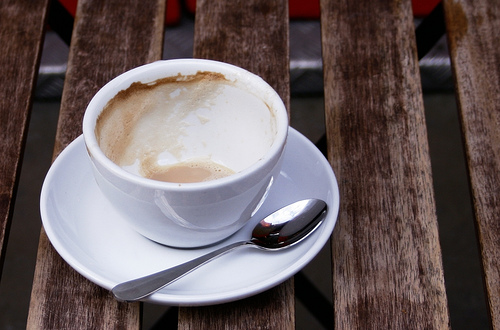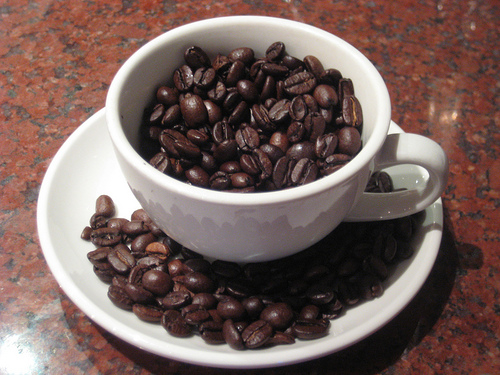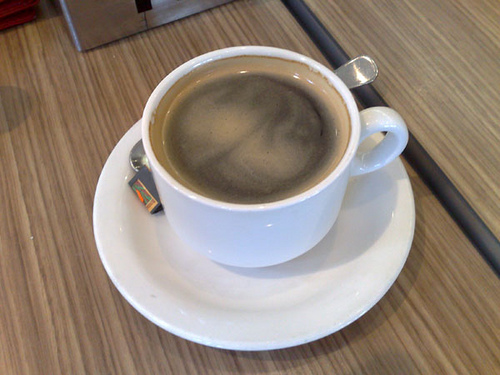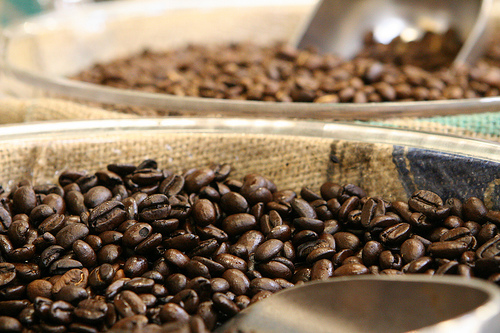
Coffee is one of the world's most popular beverages. It dukes it out with tea in this respect (although I guess water technically wins in both cases.) And yet, there are many myths and confusions around this dark, bitter mistress.
Storing coffee
A lot of people have gotten the idea that coffee should be kept in the freezer. This is not true. In fact, unless you have a commercial freezer, you are far better off keeping your coffee in the cupboard. Light and air are coffee's enemies, not temperature. Seal your coffee as well as you can - a glass jar with a tight-fitting lid is ideal - and keep it in a cool, dark pantry.
Once a coffee bean has been ground, the clock starts ticking. In theory you should only grind your beans right before you are going to use them. This isn't practical for most of us, though. If you grind your beans once a month and store the grounds well (see above) you should be doing alright. They lose flavor and potency significantly as time goes on.

Image courtesy Flickr/@dino
Part of the reason that regular grocery store brands of coffee (like Folgers) taste so terrible is that they were ground so long ago. Even the bulk beans that you grind yourself at the grocery store are a significant improvement over any coffee that is sold pre-ground.
Grinding coffee
Because freshness is key, you may want to invest in your own coffee grinder. If you can possibly swing it, get a burr grinder. A burr grinder grinds the beans between two big wheels. It gives you a much more consistent particle size than the standard whizzy blade grinders. It costs a bit more, but for the true coffee fanatic, the price of a burr grinder is worth it.

Image courtesy Flickr/amada28192
Roasting your own
True coffee fanatics buy green (unroasted) beans online and roast the beans themselves. You can do this with an air popcorn popper, although be warned that it will be a noisy and strong-smelling process. It can also be a little tricky to master, as well as time-consuming. It only saves you about a dollar per pound over the cost of some regular espresso beans from Starbucks. Thus, roasting your own should be seen as a fun hobby for the coffee addict, and not as a way to save money.
One benefit to roasting your own is that you can control exactly how roasted your beans are. If you think most coffees are too dark, or not dark enough, this is your chance to roast your coffee exactly the way you want!
Making coffee
Always start with a clean coffee pot. If you make coffee regularly, you should clean your coffee machine once a month with a solution of vinegar or citric acid.
The quality of your water determines the flavor of your coffee. If your tap water has a strong or "off" taste, then it's going to make your coffee taste bad, too. A basic Brita filter will remove weird tastes from your water to help keep your coffee tasting its best.

Image courtesy Flickr/anthony_p_c
How much coffee to use?
A lot of people are accidentally making weak, half-strength coffee. Professional coffee tasters brew with two tablespoons of beans for every six ounces of water. Because the word "cup" is uncertain when it comes to coffee, the best thing to do is measure.
Fill a one-cup measure, pour it into your coffee maker, and figure out what the lines really mean in terms of ounces. Then figure out how many tablespoons of coffee for that amount of water, and you're golden.
Most coffee scoops are two tablespoons, and most cup line markers on coffee pots indicate six ounce cups. But you can't rely on that. Measure once to find out, just to be sure!

Image courtesy Flickr/puuikibeach
Coffee makers
If you don't make coffee very often, and you don't want a whole entire coffee maker cluttering up your counter, your best option is to buy either a French press or a Bialetti Moka pot. I have one of each, and I find I greatly prefer the Moka pot.
The Moka pot makes extremely strong coffee which is just half a step from espresso. It's also nice that the whole thing is made of metal, thus you don't have to worry about breakage the way you do with a French press carafe. And finally, you don't end up with a lot of grounds at the bottom of your cup the way you do with a French press.
Main image courtesy Flickr/@Doug88888

2 comments